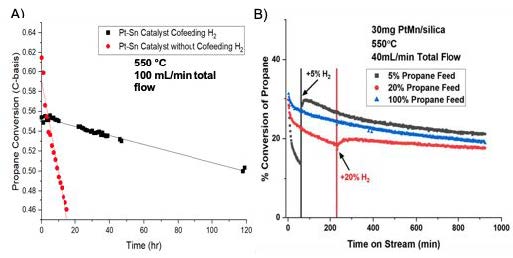Adding Hydrogen Significantly Increases the Stability of Catalysts in Shale-Gas Processing
Outcome/Accomplishment
Co-feeding hydrogen significantly reduces the accumulation of carbon, or coke, that can slow the refining of shale gas, according to research at the Center for Innovative and Strategic Transformation of Alkane Resources (CISTAR), an NSF-funded Engineering Research Center (ERC) based at Purdue University.
Impact/Benefits
The enhanced stability enables operation with fewer oxidative regenerations (once or twice a month), simplifying the process and enabling the use of a fixed-bed reactor in the CISTAR shale-gas-to-fuels-and-chemical process. Since H2 is a product of this reaction, co-feeding H2 may seem counter-intuitive; but since it allows the coke to be moved away from the active surface of the catalyst, CISTAR achieves higher rates and closer approach to equilibrium, improving process economics. Pure H2 can also be used for regeneration of the catalyst, if applied early in the cycle. This can lead to a simplified process for conversion of shale gas to valuable hydrocarbon fuels, since it avoids oxidative regeneration.
Explanation/Background
With the recent discovery of abundant reserves of unconventional shale gas resources, the potential supply of natural gas has increased significantly. Shale gas primarily contains methane with a small amount of ethane and propane – and those three alkanes are feedstocks for the primary building blocks for the chemical industry. Therefore, with its growing availability, shale gas has the potential to bring about an energy revolution for the chemical industry.
But the processing of shale gas remains expensive and energy intensive. The first step involves dehydrogenation, where catalysts lose activity due to coke deposition, requiring periodic regeneration. Co-feeding H2 prolongs catalyst lifetimes, significantly reducing the costs. Stable performance with added hydrogen demonstrates that CISTAR-developed platinum-alloy catalysts are resistant to sintering, in which catalytic particles clump, causing loss of active surface for reaction. The CISTAR catalysts can now run for weeks, compared to about one day for current commercial catalysts.
Location
West Lafayette, Indianawebsite
Start Year
Energy and Sustainability
Energy, Sustainability, and Infrastructure
Lead Institution
Core Partners
Fact Sheet
Outcome/Accomplishment
Co-feeding hydrogen significantly reduces the accumulation of carbon, or coke, that can slow the refining of shale gas, according to research at the Center for Innovative and Strategic Transformation of Alkane Resources (CISTAR), an NSF-funded Engineering Research Center (ERC) based at Purdue University.
Location
West Lafayette, Indianawebsite
Start Year
Energy and Sustainability
Energy, Sustainability, and Infrastructure
Lead Institution
Core Partners
Fact Sheet
Impact/benefits
The enhanced stability enables operation with fewer oxidative regenerations (once or twice a month), simplifying the process and enabling the use of a fixed-bed reactor in the CISTAR shale-gas-to-fuels-and-chemical process. Since H2 is a product of this reaction, co-feeding H2 may seem counter-intuitive; but since it allows the coke to be moved away from the active surface of the catalyst, CISTAR achieves higher rates and closer approach to equilibrium, improving process economics. Pure H2 can also be used for regeneration of the catalyst, if applied early in the cycle. This can lead to a simplified process for conversion of shale gas to valuable hydrocarbon fuels, since it avoids oxidative regeneration.
Explanation/Background
With the recent discovery of abundant reserves of unconventional shale gas resources, the potential supply of natural gas has increased significantly. Shale gas primarily contains methane with a small amount of ethane and propane – and those three alkanes are feedstocks for the primary building blocks for the chemical industry. Therefore, with its growing availability, shale gas has the potential to bring about an energy revolution for the chemical industry.
But the processing of shale gas remains expensive and energy intensive. The first step involves dehydrogenation, where catalysts lose activity due to coke deposition, requiring periodic regeneration. Co-feeding H2 prolongs catalyst lifetimes, significantly reducing the costs. Stable performance with added hydrogen demonstrates that CISTAR-developed platinum-alloy catalysts are resistant to sintering, in which catalytic particles clump, causing loss of active surface for reaction. The CISTAR catalysts can now run for weeks, compared to about one day for current commercial catalysts.

